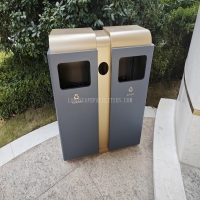Welcome to the website for landscape facilities products and knowledge.
What are the best materials for landscape bar counters in high-humidity environments?
When designing outdoor bars in humid climates, material selection becomes critical for both durability and aesthetics. High humidity accelerates deterioration of unsuitable materials, leading to warping, mold growth, and structural weakness. The ideal landscape bar counter materials combine weather resistance, low maintenance, and visual appeal.
Teak stands as a premier choice for humid environments due to its natural oils that repel moisture and resist rotting. This dense hardwood develops a beautiful silver-gray patina over time while maintaining structural integrity. Regular oiling can preserve its original golden hue if desired. The material's natural slip resistance makes it particularly suitable for bar surfaces where glasses might be placed.
Marine-grade polymer lumber offers exceptional performance in humid conditions. This recycled material mimics wood's appearance while being completely impervious to moisture. It won't splinter, crack, or support mold growth, maintaining its appearance for decades with minimal cleaning required. The material comes in various colors and textures, providing design flexibility for different landscape styles.
Stainless steel presents a modern solution for high-humidity bar counters. Its non-porous surface prevents moisture absorption and makes cleaning effortless. While prone to showing fingerprints, brushed finishes help minimize this issue. Stainless steel's heat resistance allows for direct incorporation of grills or hibachi cooking surfaces into the bar design.
Concrete countertops, when properly sealed, create impressive moisture-resistant surfaces. Modern sealing technologies make concrete highly impervious to water penetration while allowing for endless customization through coloring, texturing, and embedding elements. The material's thermal mass helps keep drinks cool in outdoor settings.
Porcelain slabs represent an emerging option with exceptional durability. These large-format tiles resist fading, scratching, and moisture absorption completely. Through-body porcelain maintains consistent color throughout the material, making chips and scratches less noticeable. The material can convincingly mimic natural stone, wood, or concrete appearances.
Composite quartz surfaces combine natural quartz with resin binders to create non-porous, stain-resistant countertops. While more common indoors, many manufacturers now offer UV-resistant versions suitable for covered outdoor applications. The material provides consistent coloring and pattern throughout the slab.
Regular maintenance remains essential regardless of material choice. Proper sealing schedules for porous materials, routine cleaning to prevent mold buildup, and protective covers during extreme weather all contribute to longevity. Incorporating slight slopes into counter design helps water runoff, while adequate ventilation prevents moisture accumulation beneath the surface.
The optimal material choice depends on specific climate conditions, design aesthetic, budget considerations, and maintenance willingness. Consulting with landscape architects familiar with local humidity patterns can provide valuable guidance for selecting materials that will maintain both function and beauty for years to come.
Related search:

Recommendation
Double-bucket garbage bin, outdoor, metal, multi-color, powder-coated, double-bucket trash can